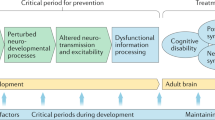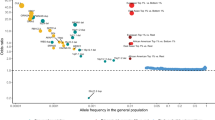Abstract
Recent studies into the etiology of schizophrenia have yielded both promising leads and disappointing dead ends, indicating the multifactored and complex nature of the disorder. The focus has subsequently shifted back to refining the phenotype and identifying clinical and biological subtypes. Recent technological breakthroughs in genomics and proteomics hold promise for advancing our understanding of the molecular pathophysiology of schizophrenia.
This is a preview of subscription content, access via your institution
Access options
Subscribe to this journal
Receive 12 print issues and online access
$209.00 per year
only $17.42 per issue
Buy this article
- Purchase on Springer Link
- Instant access to full article PDF
Prices may be subject to local taxes which are calculated during checkout

Similar content being viewed by others
References
Kraepelin, E. Dementia Praecox and Paraphrenia. (Huntington, New York, 1919).
Bleuler, M. Demential Praecox or the Group of Schizophrenias. (International Universities Press, New York, 1950).
Abi-Dargham, A. et al. Increased striatal dopamine transmission in schizophrenia: confirmation in a second cohort. Am. J. Psychiatry 155, 761–767 (1998).
Breier, A. et al. Schizophrenia is associated with elevated amphetamine-induced synaptic dopamine concentrations: Evidence from a novel positron emission tomography method. Proc. Natl. Acad. Sci. USA 94, 2569–2574 (1997).
Tamminga, C.A. Schizophrenia and glutamatergic transmission. Crit. Rev. Neurobiol. 12, 21–36 (1998).
Smiley, J.F., Levey, A.I., Ciliax, B.J. & Goldman-Rakic, P.S. D1 dopamine receptor immunoreactivity in human and monkey cerebral cortex: predominant and extrasynaptic localization in dendritic spines. Proc. Natl. Acad. Sci. USA 91, 5720–5724 (1994).
Bergson, C. et al. Regional, cellular, and subcellular variations in the distribution of D1 and D5 dopamine receptors in primate brain. J. Neurosci. 15, 7821–7836 (1995).
Otani, S., Auclair, N., Desce, J.M., Roisin, M.P. & Crepel, F. Dopamine receptors and groups I and II mGluRs cooperate for long-term depression induction in rat prefrontal cortex through converging postsynaptic activation of MAP kinases. J. Neurosci. 19, 9788–9802 (1999).
Seamans, J.K., Durstewitz, D., Christie, B.R., Stevens, C.F. & Sejnowski, T.J. Dopamine D1/D5 receptor modulation of excitatory synaptic inputs to layer V prefrontal cortex neurons. Proc. Natl. Acad. Sci. USA 98, 301–306 (2001).
Gao, W.J., Krimer, L.S. & Goldman-Rakic, P.S. Presynaptic regulation of recurrent excitation by D1 receptors in prefrontal circuits. Proc. Natl. Acad. Sci. USA 98, 295–300 (2001).
Benes, F.M. Emerging principles of altered neural circuitry in schizophrenia. Brain Res. Brain Res. Rev. 31, 251–269 (2000).
Bogerts, B. The neuropathology of schizophrenic diseases: historical aspects and present knowledge. Eur. Arch. Psychiatry Clin. Neurosci. 249 (Suppl. 4), 2–13 (1999).
Sanfilipo, M. et al. Volumetric measure of the frontal and temporal lobe regions in schizophrenia: relationship to negative symptoms. Arch. Gen. Psychiatry 57, 471–480 (2000).
Selemon, L.D. & Goldman-Rakic, P.S. The reduced neuropil hypothesis: a circuit based model of schizophrenia. Biol. Psychiatry 45, 17–25 (1999).
Glantz, L.A. & Lewis, D.A. Decreased dendritic spine density on prefrontal cortical pyramidal neurons in schizophrenia. Arch. Gen. Psychiatry 57, 65–73 (2000).
Lidow, M.S. et al. Antipsychotic treatment induces alterations in dendrite- and spine-associated proteins in dopamine-rich areas of the primate cerebral cortex. Biol. Psychiatry 49, 1–12 (2001).
Mirnics, K., Middleton, F.A., Marquez, A., Lewis, D.A. & Levitt, P. Molecular characterization of schizophrenia viewed by microarray analysis of gene expression in prefrontal cortex. Neuron 28, 53–67 (2000).
Mednick, S.A., Machon, R.A., Huttunen, M.O. & Bonett, D. Adult schizophrenia following prenatal exposure to an influenza epidemic. Arch. Gen. Psychiatry 45, 189–192 (1988).
Karlsson, H. et al. Retroviral RNA identified in the cerebrospinal fluids and brains of individuals with schizophrenia. Proc. Natl. Acad. Sci. USA 98, 4634–4639 (2001).
Kendler, K.S. & Diehl, S.R. Schizophrenia: Genetics. in Comprehensive Textbook of Psychiatry. Vol. VI (eds. Kaplan, H.I. & Sadock, B.J.) 942–957 (Williams and Wilkins, Baltimore, Maryland, 1995).
Cannon, T.D., Kaprio, J., Lonnqvist, J., Huttunen, M. & Koskenvuo, M. The genetic epidemiology of schizophrenia in a Finnish twin cohort. A population-based modeling study. Arch. Gen. Psychiatry 55, 67–74 (1998).
Tsuang, M.T., Stone, W.S. & Faraone, S.V. Schizophrenia: a review of genetic studies. Harv. Rev. Psychiatry 7, 185–207 (1999).
Pulver, A.E. Search for schizophrenia susceptibility genes. Biol. Psychiatry 47, 221–230 (2000).
Thaker, G.K. Defining the schizophrenia phenotype. Current Psychiatry Reports 2, 398–403 (2000).
Carpenter, W.T. Jr, Heinrichs, D.W. & Wagman, A.M. Deficit and nondeficit forms of schizophrenia: The concept. Am. J. Psychiatry 145, 578–583 (1988).
Fenton, W.S. & McGlashan, T.H. Antecedents, symptom progression, and long-term outcome of the deficit syndrome in schizophrenia. Am. J. Psychiatry 151, 351–356 (1994).
Waltrip, R.W. et al. Borna disease virus antibodies and the deficit syndrome of schizophrenia. Schizophr. Res. 23, 253–257 (1997).
Kirkpatrick, B., Buchanan, R.W., Ross, D.E. & Carpenter, W.T.J. A separate disease within the syndrome of schizophrenia. Arch. Gen. Psychiatry 58, 165–171 (2001).
Ross, D.E. et al. Sibling correlation of deficit syndrome in the Irish study of high-density schizophrenia families. Am. J. Psychiatry 157, 1071–1076 (2000).
Tamminga, C.A. et al. Limbic system abnormalities identified in schizophrenia using positron emission tomography with fluorodeoxyglucose and neocortical alterations with deficit syndrome. Arch. Gen. Psychiatry 49, 522–530 (1992).
Carpenter, W.T. Jr, Buchanan, R.W., Kirkpatrick, B., Tamminga, C.A. & Wood, F. Strong inference, theory testing, and the neuroanatomy of schizophrenia. Arch. Gen. Psychiatry 50, 825–831 (1993).
Holzman, P.S., Proctor, L.R. & Hughes, D.W. Eye-tracking patterns in schizophrenia. Science 181, 179–181 (1973).
Arolt, V. et al. Eye tracking dysfunction is a putative phenotypic susceptibility marker of schizophrenia and maps to a locus on chromosome 6p in families with multiple occurrence of the disease. Am. J Med. Genet. 67, 564–579 (1996).
Cannon, T.D. et al. Neuropsychological functioning in siblings discordant for schizophrenia and healthy volunteers. Arch. Gen. Psychiatry 51, 651–661 (1994).
Callicott, J.H. et al. Hippocampal N-acetyl aspartate in unaffected siblings of patients with schizophrenia: a possible intermediate neurobiological phenotype. Biol. Psychiatry 44, 941–950 (1998).
Freedman, R., Adler, L.E. & Leonard, S. Alternative phenotypes for the complex genetics of schizophrenia. Biol. Psychiatry 45, 551–558 (1999).
Freedman, R. et al. Linkage of a neurophysiological deficit in schizophrenia to a chromosome 15 locus. Proc. Natl. Acad. Sci. USA 94, 587–592 (1997).
Freedman, R. & Leonard, S. Schizophrenia and 15q14. Am. J. Med. Genet. (in the press).
Carlsson, A. & Lindquist, M. Effect of chlorpromazine and haloperidol of formation of 3- methoxytyramine and normetanephrine in mouse brain. Acta Pharmacol. Toxicol. 140–144 (1963).
Kane, J., Honigfeld, G., Singer, J. & Meltzer, H. Clozapine for the treatment-resistant schizophrenic. A double-blind comparison with chlorpromazine. Arch. Gen. Psychiatry 45, 789–796 (1988).
Goff, D.C., Tsai, G., Manoach, D.S. & Coyle, J.T. Dose-finding trial of D-cycloserine added to neuroleptics for negative symptoms in schizophrenia. Am. J. Psychiatry 152, 1213–1215 (1995).
Heresco-Levy, U. et al. Efficacy of high-dose glycine in the treatment of enduring negative symptoms of schizophrenia. Arch. Gen. Psychiatry 56, 29–36 (1999).
Mirnics, K., Middleton, F.A., Stanwood, G.D., Lewis, D.A. & Levitt, P. Disease-specific changes in regulator of G-protein signaling 4 (RGS4) expression in schizophrenia. Mol. Psychiatry, 293–301 (2001).
Brzustowicz, L.M., Hodgkinson, K.A., Chow, E.W., Honer, W.G. & Bassett, A.S. Location of a major susceptibility locus for familial schizophrenia on chromosome 1q21-q22. Science 288, 678–682 (2000).
Sherrington, R. et al. Localization of a susceptibility locus for schizophrenia on chromosome 5. Nature 336, 164–167 (1988).
Arolt, V. et al. Eye tracking dysfunction is a putative phenotypic susceptibility marker of schizophrenia and maps to a locus on chromosome 6p in families with multiple occurrence of the disease. Am. J. Med. Genet. 67, 564–579 (1996).
Pulver, A.E. et al. Genetic heterogeneity in schizophrenia: stratification of genome scan data using co-segregating related phenotypes. Mol. Psychiatry 5, 650–653 (2000).
Detera-Wadleigh, S.D. et al. A high-density genome scan detects evidence for a bipolar-disorder susceptibility locus on 13q32 and other potential loci on 1q32 and 18p11.2. Proc. Natl. Acad. Sci. USA 96, 5604–5609 (1999).
Myles-Worsley, M. et al. Linkage of a composite inhibitory phenotype to a chromosome 22q locus in eight Utah families. Am. J. Med. Genet. 88, 544–550 (1999).
Scambler, P.J. et al. Velo-cardio-facial syndrome associated with chromosome 22 deletions encompassing the DiGeorge locus. Lancet 339, 1138–1139 (1992).
Kelsoe, J.R. et al. A genome survey indicates a possible susceptibility locus for bipolar disorder on chromosome 22. Proc. Natl. Acad. Sci. USA 98, 585–590 (2001).
Baron, M. Genetics of schizophrenia and the new millennium: progress and pitfalls. Am. J. Hum. Genet. 68, 299–312 (2001).
Egan, M.F. et al. Effect of COMT val108/158met genotype on frontal lobe function and risk for schizophrenia. Proc. Natl. Acad. Sci. USA (in the press).
Berrettini, W.H. Are schizophrenic and bipolar disorders related? A review of family and molecular studies. Biol. Psychiatry 48, 531–538 (2000).
Acknowledgements
Support was received from NIH grants MH49826 and 40279 and the W.K. Warren Medical Research Institute.
Author information
Authors and Affiliations
Rights and permissions
About this article
Cite this article
Thaker, G., Carpenter, W. Advances in schizophrenia. Nat Med 7, 667–671 (2001). https://doi.org/10.1038/89040
Issue Date:
DOI: https://doi.org/10.1038/89040
This article is cited by
-
Exploration of the role of emotional expression of treatment-resistant schizophrenia patients having followed virtual reality therapy: a content analysis
BMC Psychiatry (2023)
-
Different responses to risperidone treatment in Schizophrenia: a multicenter genome-wide association and whole exome sequencing joint study
Translational Psychiatry (2022)
-
Eye movement characteristics in male patients with deficit and non-deficit schizophrenia and their relationships with psychiatric symptoms and cognitive function
BMC Neuroscience (2021)
-
Novel genetic susceptibility loci identified by family based whole exome sequencing in Han Chinese schizophrenia patients
Translational Psychiatry (2020)
-
Insulin resistance induced by olanzapine and other second-generation antipsychotics in Chinese patients with schizophrenia: a comparative review and meta-analysis
European Journal of Clinical Pharmacology (2019)



